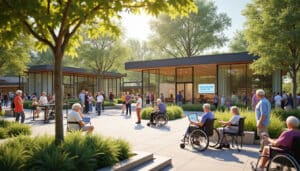The demographic transition represents a complex process marking the shift from a regime of high birth and death rates to a model where these figures gradually decline. This phenomenon, observable on a global scale, leads to significant social and economic transformations. The increase in life expectancy and the decline in birth rates modify the structure of populations, creating specific challenges for societies, notably in terms of aging, social isolation, and financing social protection systems. These issues require particular attention to design solutions tailored to the needs of a constantly evolving population.
The demographic transition is a major concept in demography that describes the shift from a population characterized by high birth and death rates to a population where these rates are low. This process generally occurs in several phases, allowing for the understanding of societal evolution over time.
The first phase, known as the old regime, is marked by high death and birth rates. During this period, women give birth to many children to compensate for losses due to high infant mortality. This demographic model is typical of largely rural and agrarian societies, where access to healthcare is limited.
The second phase indicates the beginning of the decline in mortality. Advances in healthcare, hygiene, and nutrition contribute to an increase in life expectancy. Countries begin to benefit from historic records regarding infant mortality, thereby allowing for an extension of adult life. This phenomenon leads to an increasing imbalance between the number of births and deaths.
The third phase is characterized by the decline in birth rates. Fertility rates decrease due to changes in living conditions, urbanization, and societal shifts. This phenomenon is often linked to better access to education, especially for women, and the emergence of a culture of contraception. Families then choose to reduce the number of children to focus on the quality of education and well-being for each of them.
The final phase of the demographic transition is marked by the stabilization of birth and death rates, leading to a balanced population. Developed countries such as those in Europe or North America have reached this stage. However, disparities remain between regions of the world, and some countries in Africa or Asia continue to experience an unfinished demographic transition.
The stakes of the demographic transition are multiple and vital for the future development of our societies. For example, one of the major issues relates to the aging population. In Europe, the proportion of people aged 60 and over is expected to reach 35% by 2050, while the birth rate continues to decline. This imposes significant challenges in terms of financing pensions and organizing care for the elderly.
Another important issue is the evolution of health services and social protection systems. The growing need for suitable care for an aging population requires structural adjustments in our approach to healthcare. Accessibility to local services, the creation of an inclusive urban environment, and maintaining shops and services also play a crucial role in supporting the elderly and combating social isolation.
Finally, the demographic transition also raises questions about the housing of the elderly. Many seniors wish to live at home, but infrastructures must be adapted to meet this demand. Creating new housing models, such as family pensions, intergenerational co-housing, and other innovative solutions, is essential to anticipate the growing challenge of elderly individuals who prefer to age at home.
Thus, the demographic transition is a complex process that leads to profound changes in social, economic, and cultural structures, necessitating particular attention to mitigate negative impacts and maximize benefits for society as a whole.

“`html
FAQ: Understanding the Demographic Transition
The demographic transition is the process by which a society shifts from a population characterized by high mortality and high birth rates to a population where mortality and birth rates are low, thereby enabling a modern demographic balance.
Why is an aging population a concern?
An aging population leads to an inversion of the age pyramid, with more elderly individuals than young people, posing challenges regarding the financing of social protection systems, accessibility of services, and social isolation of seniors.
What are the causes of demographic aging?
The main causes are increased life expectancy and low birth rates, which affect each country differently based on their demographic history.
What are the challenges of an aging population?
Among the major challenges are isolation of the elderly, access to care, adequate housing, and financing autonomy.
How will the aging population be managed?
It is essential to rethink our society to make it more inclusive by developing solutions such as intergenerational co-housing and improving local services.
What is the role of demographic policies?
Demographic policies must play a crucial role in the management of challenges related to the demographic transition, particularly through education and the development of solutions tailored to the needs of the elderly.











